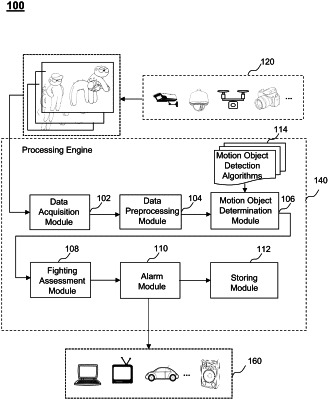| CPC G06V 20/52 (2022.01) [G06T 7/248 (2017.01); G06V 20/10 (2022.01); G06V 20/41 (2022.01); G06V 20/44 (2022.01)] | 19 Claims |

|
1. A system, comprising:
a computer-readable storage medium storing executable instructions for detecting abnormal scene; and
at least one processor in communication with the computer-readable storage medium, when executing the executable instructions, the at least one processor is directed to:
obtain data relating to a video scene;
identify at least two motion objects and at least one surrounding object in the video scene based on the data and one or more motion object detection algorithms, wherein the at least one surrounding object is within a pre-determined range from the at least two motion objects, the one or more motion object detection algorithms include an inter-frame difference algorithm, a background difference algorithm, or an optical flow algorithm;
determine a first motion feature relating to the at least two motion objects based on the data;
determine a second motion feature relating to at least one portion of each of the at least two motion objects based on the data, the portion of each of the at least two motion objects includes a hand, an arm, a finger, a thumb, a foot, an elbow, a knee or a head;
determine a third motion feature relating to the at least one surrounding object in the video scene;
determine a historical statistic relating to historical fighting events, each of the historical fighting events referring to a fighting event that occurred in a day in history at a same area as the video scene and that the at least two motion objects were involved in; and
determine whether the at least two motion objects in the video scene are involved in a fight by accessing a motion feature vector using a pre-determined model, the motion feature vector including the first motion feature, the second motion feature, the third motion feature, and the historical statistic, the pre-determined model being determined using a machine learning technique.
|